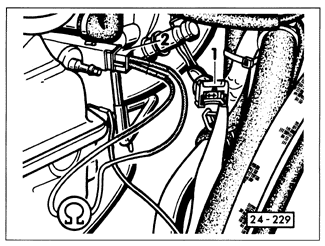Testing InjectorsA faulty injector can be detected by checking resistance at the main electrical connector on the end of the fuel rail, as shown in Fig. 4-35. The resistance should be between 3.7 and 5.0 ohms. If the resistance is greater, at least one injector is faulty.

To isolate a faulty injector, disconnect the individual electrical connectors from the injectors, one at a time, and retest. The resistance should increase each time an injector is disconnected. Table g lists the approximate resistance values. If the resistance does not increase when a particular injector is disconnected, check the resistance directly at that injector. The resistance should be between 15 and 20 ohms. If it is, check the wiring between the main connector and the injector connector. If it is not, the injector is faulty and should be replaced. Table g. Digifant II Fuel Injector Resistance
To check if the injectors are receiving voltage signals, connect an LED test light to the wiring harness connector as shown in Fig. 4-36. With the transmission in neutral and the parking brake set, activate the starter and check that the LED flickers. If not, test the Digifant control unit as described in 7.4 Electrical Tests or check for a fault in the wiring harness to the injector connector.

|
